Amache Prowers facts for kids
Quick facts for kids
Amache Ochinee Prowers
|
|
|---|---|
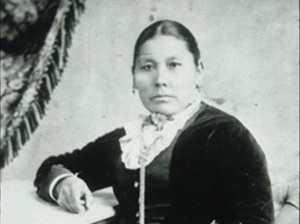
Amache Prowers, Cheyenne mediator, wife of John Wesley Prowers, late 19th century
|
|
| Born |
Amache Ochinee (Walking Woman)
1846 Southeastern Colorado plains
|
| Died | 1905 |
| Nationality | Cheyenne |
| Citizenship | Native American |
| Occupation | Mediator, cattle-rancher, business woman |
| Spouse(s) | John Wesley Prowers |
| Parent(s) |
|
Amache Ochinee Prowers (1846–1905) was a brave Native American woman. She was also known as Walking Woman. Amache was a strong voice for her people and a successful cattle rancher. She also ran a store along the famous Santa Fe Trail.
Her father was a Cheyenne peace chief. He was sadly killed during the terrible Sand Creek massacre in 1864. After this, Amache became a very important person. She helped bring peace between settlers, Mexicans, and Native Americans in Colorado during the 1860s and 1870s. In 2018, she was honored by being added to the Colorado Women's Hall of Fame.
Contents
Her Life Story
Growing Up
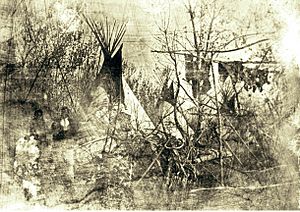
Amache was a full-blooded member of the Southern Cheyenne tribe. She was born in the summer of 1846. This was during a time when her tribe was forced to move across the plains of Southeastern Colorado. Her father, Ochinee, was a Cheyenne Peace Chief. He often camped near Bent's Fort with other Cheyenne people.
In 1846, many white people started arriving in the Arkansas River Valley. General Stephen W. Kearny led U.S. soldiers through Colorado during the Mexican–American War. The Cheyenne saw more and more white traders on the Santa Fe Trail.
As a Cheyenne child, Amache had a lot of freedom. When she had her first menstrual cycle, she learned important skills. These included cleaning, tanning hides, and cooking. She took on other duties of Cheyenne women.
Marriage and Family
John Wesley Prowers was a trader who worked at Bent's Fort. He saw Amache dance around 1860. The next year, he asked her father, Chief Ochinee, if he could marry her. They followed Cheyenne traditions, exchanging gifts during their courtship.
In 1861, when Amache was about 15 or 16, she married John Wesley Prowers. He was a cattleman and trader. After they married, they lived in Westport, Missouri for a few months. There, Amache learned about the ways of white women. She faced prejudice, with some people calling her "that Indian woman."
John and Amache worked together in their businesses. In 1867, they settled in Boggsville, Colorado along the Santa Fe Trail. They lived in a large 14-room adobe house. This house is now a historic site in Bent County, Colorado. They raised nine children there. Their children grew up knowing both European and Native American cultures.
Amache was very good at blending her Cheyenne culture with Mexican and Euro-American ways. She wore clothes like white women, except for a corset. She always spoke English at home. But she also taught her children words from the Cheyenne language. She kept Cheyenne traditions alive in her family. For example, she made traditional foods like pickled prickly pears and buffalo meat rolls. She also made preserves from wild fruits and tea from sage leaves. She knew which herbs to use for medicine.
Amache's mother also taught her grandchildren about Cheyenne traditions. Amache even kept a tepee at her home. This helped her stay connected to her Native American heritage. Her mother and other family members often visited the Prowers home. Amache was known as a kind woman. She was active in school, church, and community events. She was friends with Mary Bent, whose mother was Owl Woman.
In 1873, the Prowers family moved to Las Animas, Colorado. John Wesley Prowers became a politician. He passed away in 1884. Amache received money each year to raise her children. In 1891, she married Dan Keesee. She died in 1905 in Cambridge, Massachusetts.
The Sand Creek Massacre
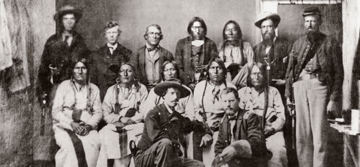
Amache's father helped make a peace agreement. This allowed the Cheyenne and Arapaho to camp safely along Sand Creek in the winter of 1864–1865. He had met with the Governor of Colorado, John Evans. Colonel John Chivington even said that Amache's father was a "friendly Indian."
Before the attack, Amache and her family were held captive. This was to stop them from warning the Cheyenne at Sand Creek. John Wesley Prowers later said:
I was taken prisoner one Sunday evening... by men of company E, first cavalry of Colorado... and not allowed to leave the house... because I had an Indian family. The colonel commanding thought I might communicate some news to the Indians encamped on Sand [C]reek.
—John Wesley Prowers
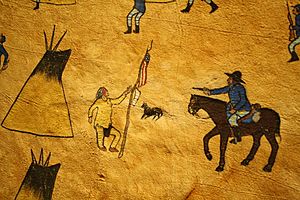
On November 29, 1864, the Cheyenne camp at Sand Creek was attacked. About 600 soldiers from the Colorado Volunteer Cavalry attacked them. Amache's father, Peace Chief Ochinee, was killed. About 160 other people died, mostly children and women. Her mother managed to escape. Colonel John Chivington led the troops.
Amache later went to the United States Congress with her husband. She spoke out to get justice for the Cheyenne people. She, her two oldest daughters, and her mother each received land from the U.S. government. Amache used her land to make her family's cattle ranch bigger. Years later, Amache was asked if she knew Colonel Chivington. Her daughter Mary said that Amache stood tall and said, "Know Col. Chivington? I should. He was my father's murderer!" She then turned her back on him.
A Smart Businesswoman
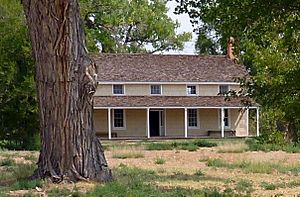
Amache and her husband ran a store, hotel, post office, and school. Their home in Boggsville was on the Santa Fe Trail. It was a place where people from different backgrounds met. These included Euro-Americans, Native Americans, and Latin people. Amache spoke English, Spanish, and Cheyenne. She could not read or write, though.
She helped manage her family's cattle ranch. Her husband was thought to have brought the first Hereford cattle to Colorado. He started buying cattle in 1862. He became the first and largest rancher in the area. By 1881, they had 15,000 cattle. However, severe blizzards in 1885–1887 caused huge losses. This almost destroyed the cattle industry in Colorado.
A Bridge Between Cultures
Amache became a leader in the Southern Cheyenne tribe. In the early years of Colorado as a territory (1860s and 1870s), she was a skilled mediator. She helped different groups get along. These groups included Mexican, Native American, and Euro-American people. As more people settled in Colorado, her diplomatic skills helped her protect the land she received.
Dr. Bonnie Clark, who wrote about Amache Prowers, said something important. She said Amache lived during a time of big changes. Amache helped build the foundation of the American West.
Her Legacy
Amache died in 1904 or 1905 in Cambridge, Massachusetts. She was buried in the Las Animas cemetery.
A place called Camp Amache was named after her. It was near Granada, Colorado. This camp was set up in 1942. It was a Japanese-American internment camp during World War II. Amache was honored in 2018. She was inducted into the Colorado Women's Hall of Fame.
See Also
Images for kids
-
The only surviving daguerreotype from Solomon Nunes Carvalho's journey West in 1853 depicts a view of the Cheyenne village at Big Timbers. A pair of figures stand to the left; drying hides hang on the right. Courtesy of Library of Congress.
-
Portion of winter count depicting Black Kettle at Sand Creek. (Buffalo Bill Center of the West)
-
Prowers House in Boggsville, Colorado






